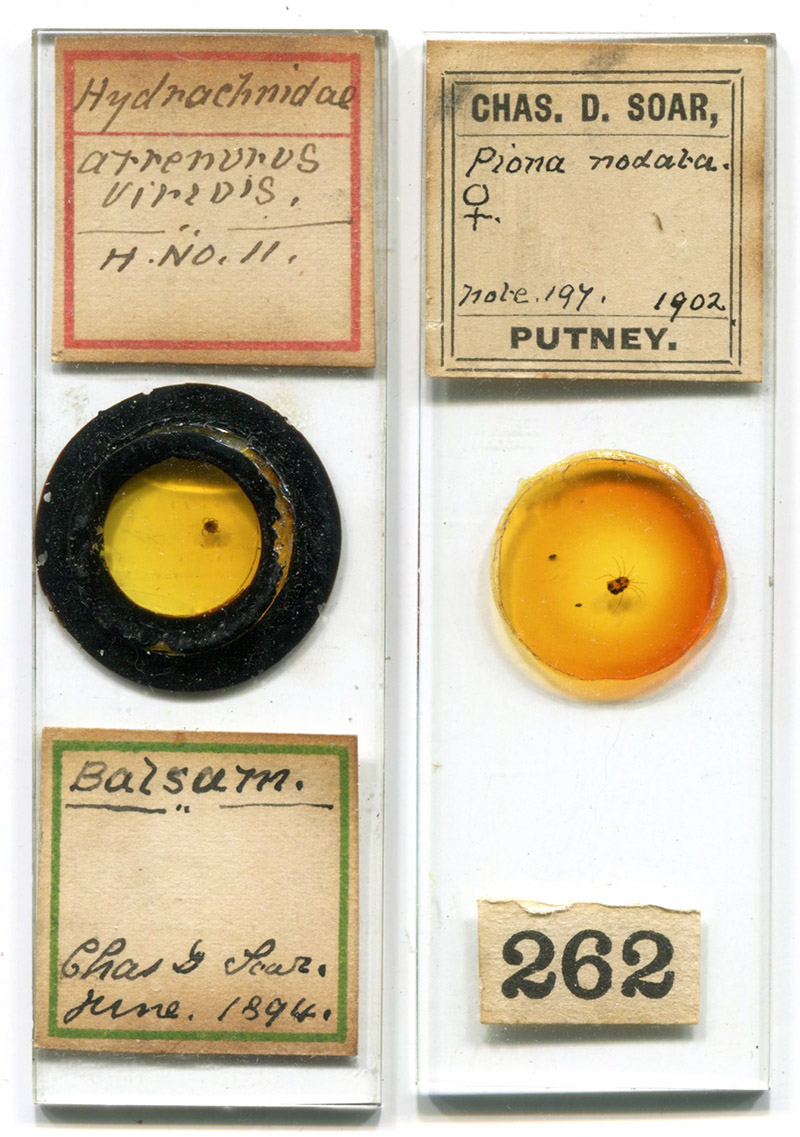
Figure 1. Microscope slides by C.D. Soar, with his handwritten name (dated 1894) and with a custom-printed label (dated 1902). Soar moved to Putney during the 1890s.
Charles David Soar, 1853 - 1939
by Brian Stevenson
last updated June, 2021
Without any formal training, C.D. Soar became a world-renowned expert on Hydrachnidiae (or Hydracarina, the "water mites"). Evidently, Soar followed a route used by professional and amateur scientist before and since: he recognized an interesting gap in knowledge, then committed himself to fill that niche. Soar became a Fellow of the Royal Microscopical Society (serving on RMS Council from 1915-1918), Fellow of the Linnean Society, and Member of the Ray Society and the Quekett Microscopical Club (serving as President of the QMC from 1935-1936).
Soar's microscope slides are occasionally seen in collections (Figures 1 and 2). All were probably made for scientific purposes, and, although not necessarily elegantly finished, Soar's slides are of scientific and historical importance. They were used as references for his many publications on water mites (Figures 3-5).
Brian Bracegirdle's Microscopical Mounts and Mounters includes an image of a C.D. Soar slide in plate 34-A. Dr. Bracegirdle described Soar as an "artist", which is partly correct. Charles Soar was a skilled wood carver who specialized in producing frames for paintings (Figure 7).

Figure 1.
Microscope slides by C.D. Soar, with his handwritten name (dated 1894) and with a custom-printed label (dated 1902). Soar moved to Putney during the 1890s.
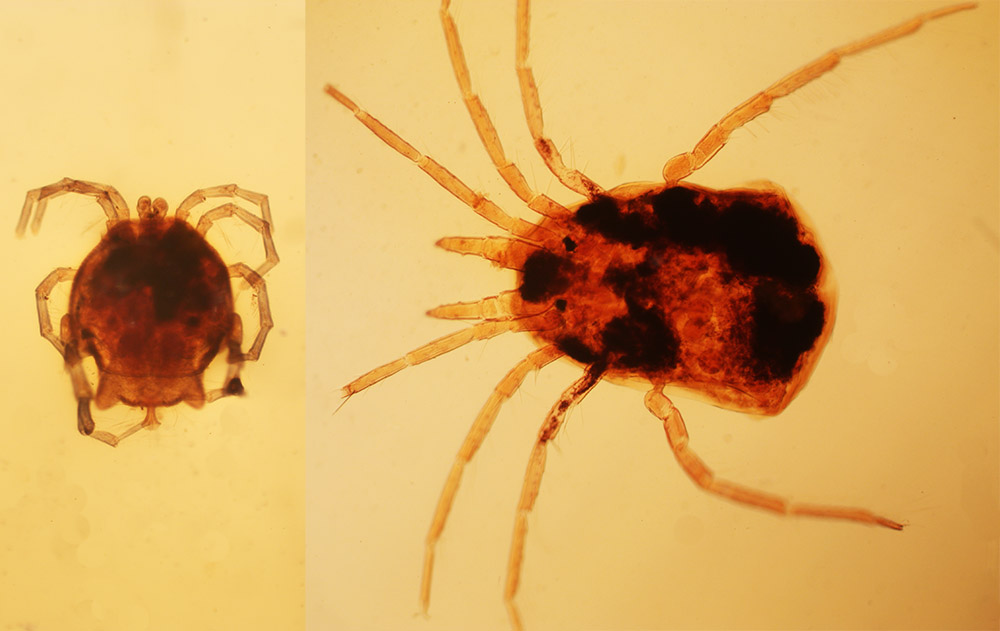
Figure 2.
Water mites that were mounted by Charles Soar (see Figure 1): Arrenurus viridis (left) and Piona nodata (right), both shown at the same relative magnification. Photographed with a 3.5x objective lens and transmitted light with a C-mounted digital SLR camera on a Leitz Ortholux II microscope.
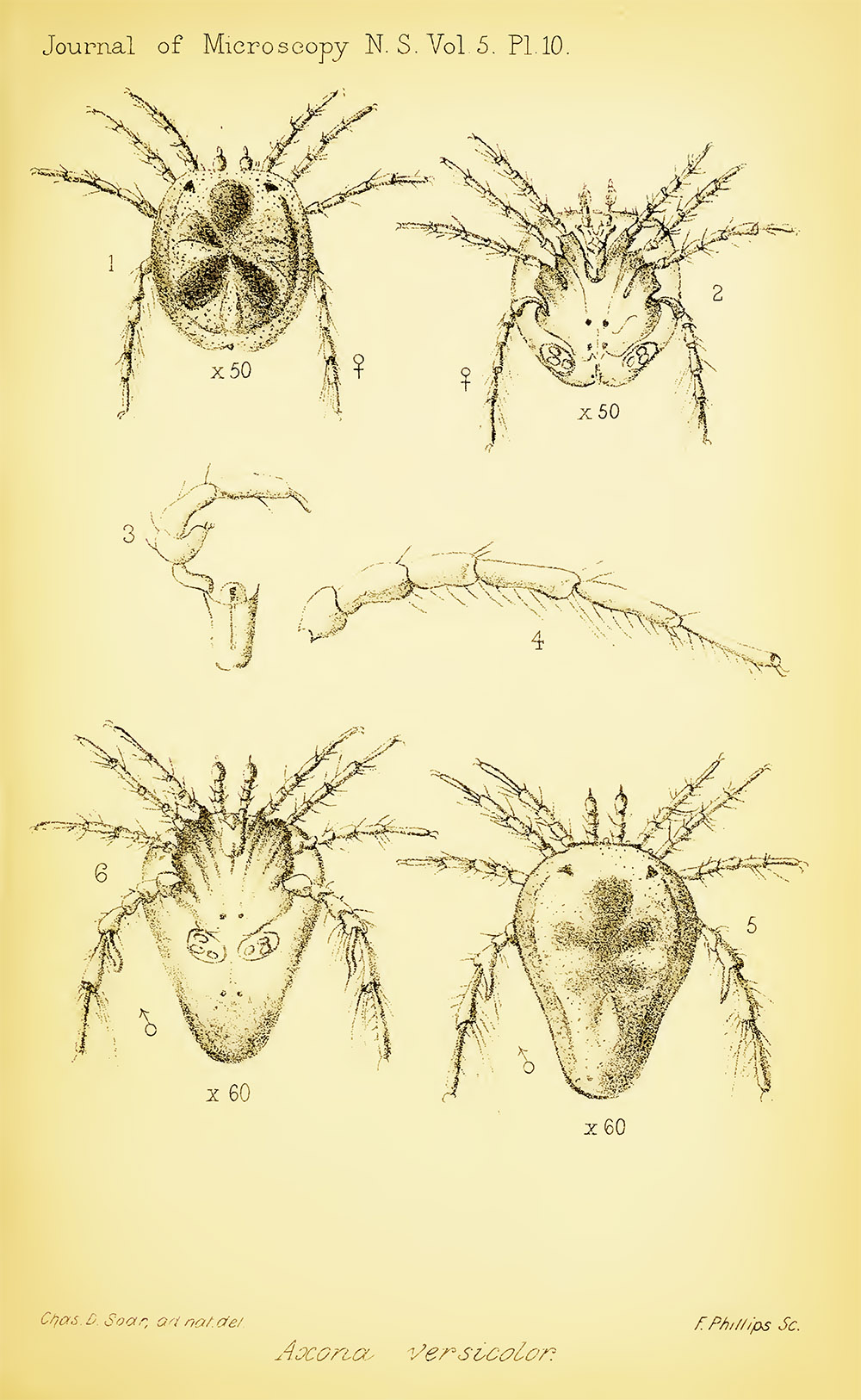
Figure 3.
Drawings of Axona versicolor water mites by C.D. Soar, from his 1895 paper, "British hydrachnidae".
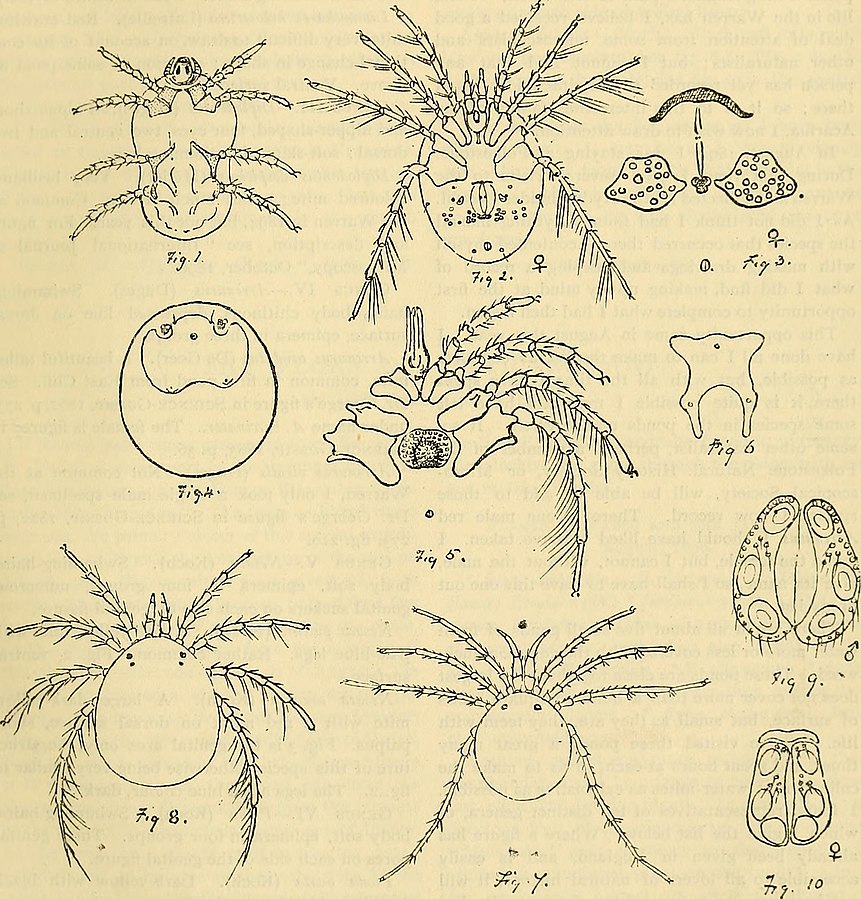
Figure 4.
Illustrations by C.D. Soar from his 1896 paper, "Water-mites of Folkestone Warren".
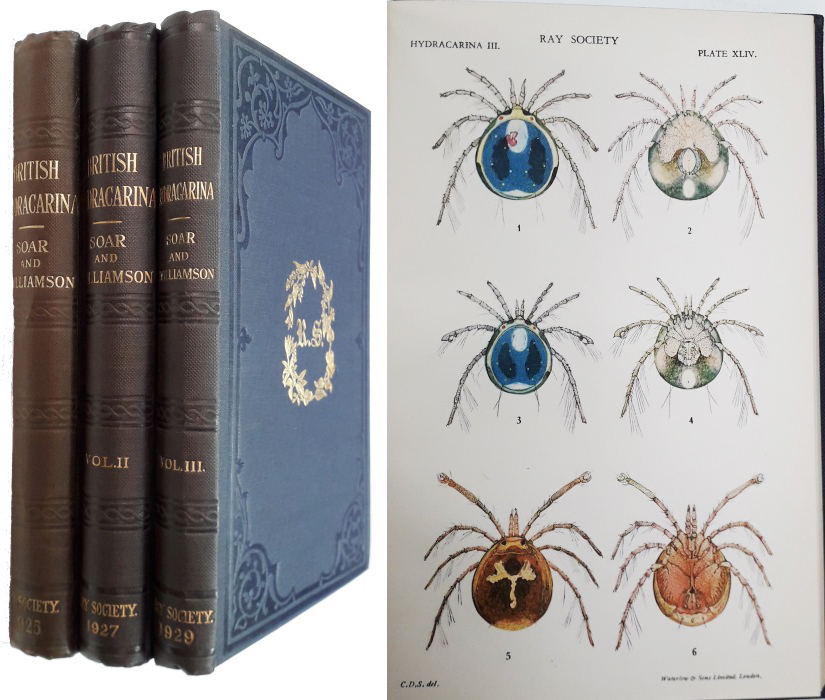
Figure 5.
Charles Soar and William Williamson published three volumes of "The British Hydracarina", in 1925, 1927, and 1929. Images adapted for nonprofit, educational purposes from an internet retail site.

Figure 6.
A relatively young Charles David Soar, adapted for nonprofit, educational purposes from an undated photograph at https://www.ancestry.com/family-tree/person/tree/113687212/person/280120720976/facts
Charles Soar's parents, John Soar and Sarah Abbott, met while they worked as servants in Leyton, Essex. He was a coachman, and she was a domestic servant in a nearby residence. They married in 1852, and gave birth to their first child, Charles, in 1853. A few years later, they moved to Paddington, London, with John continuing his coachman's trade.
By the end of the 1860s, Charles had been apprenticed to a "gilder", that is, one who coats items with gold leaf. His master was probably Robert Varley (1839-1903), with whom he later formed a partnership. Varley's entry in the 1871 England census described his occupation as "gilder decorator", while Soar was listed as a "gilder's apprentice".
Varley and Soar probably formed their partnership during the mid- to late 1870s. Soar was evidently secure enough by 1878 that he could get married. His wife was Mary Ann Samson, who had grown up a couple of doors down from the Soar family. Her father also worked as a coachman.
Varley and Soar established their picture frame making and gilding/painting business on Great Ormond Street, London (Figure 8). The 1881 census described Soar as "carver and gilder, junior partner", and Varley as "gilder and painter, frame maker".
By 1883, Soar had established an independent frame-making business, at Sussex Villas, Kensington, London (Figure 9). His son, John (born in 1879), and daughter, Grace (born in 1881), both helped with the business. John later became a partner with his father (Figure 9). Charles reportedly said that his daughter "turned out some good work until she turned it up on marriage".
Charles Soar joined the Quekett Microscopical Club in 1892. His membership implies that Soar had been involved with microscopical studies for some time before that date.
In 1895, Soar published his first paper on water mites, beginning with "When we consider the great number of natural history societies and microscopical clubs that are in existence in Great Britain, it makes one wonder why that interesting family of the Acarina - viz., Hydrachnidae - have been so long neglected. Perhaps the want of good text-books on the subject is the reason. There is no work on the Hydrachna in English. Andrew Murray, in his 'Economic Entomology – Aptera', mentions a few species, but some of them are wrongly named and the drawings very bad. Dr. F.C. George, in the pages of Science Gossip, gave a few papers and a few good illustrations, but did not get further than a few species of one genus. The last edition of Carpenter dismisses the subject in about six lines. There are a few isolated papers in Microscopical Journals, but I do not think any are much more than a mere reference to the subject. On the Continent a great deal has been written from Müller to Neumann. I propose, with the editor's permission, to give a paper from time to time on the British Hydrachnidae, each paper to illustrate a genus, with one species merely as an example; the letterpress to be as brief as the subject will allow. This, I hope, will lay a foundation for anyone about to take up the study of these interesting mites. The illustrations will all be from my own drawings taken from the life and all measurements in English". This was followed by a brief description of the genus Axona, and details of the species A. versicolor with a plate of drawings by Soar (Figure 3).
The following year, 1896, Soar published the a description of water mites that he collected near Folkestone, Kent. The introductory paragraphs are lovely writing, describing both the location and his methods of collecting and studying: "At the east end of the fashionable watering-place on the Kentish coast, so well-known as Folkestone, is a wild, rugged piece of land called the Warren, well-known to most visitors to that no doubt was formed in the first instance by an enormous landslip. It is of great wildness and beauty, the surface is undulating, no part is flat; it is all hillocks and hollows, clothed with a delightful resort. It extends from the East Cliff, Folkestone, alongside the sea towards Dover for about two miles. The northern side is walled in by a high chalky cliff, which reaches as much as 450 feet above sea-level. This rugged undercliff, beautiful green herbage, and in places thickly covered with brambles and thickets. There are a few small trees, but very few. To the naturalist the Warren has particular attractions. Geologists, entomologists and botanists can spend time here to great advantage in collecting. One cannot go to the Warren at any time of the summer season without finding some votaries of some of the natural sciences pursuing their hobby: geologists with their hammers, entomologists with their collecting nets, and the botanist with his tin vasculum. At the bottom of several hollows in the Warren, are some small ponds of water, and it was to these ponds during August I paid several visits. Pond life in the Warren has, I believe, received a good deal of attention from some microscopists and other naturalists; but I cannot find that any person has yet recorded the Hydrachnides found there; so it is to this interesting family of the Acarina, I now wish to draw attention. … There are in all about five small ponds of fresh water more or less covered with the common duckweed. These ponds are close together; the largest does not cover more than a hundred square yards of surface, but small as they are, they teem with life. I have visited these ponds a great many times, and spent hours at each, so as to make the collection of water-mites as exhaustive as possible. I found representatives of ten distinct genera, of which I give the list below. Where a figure has already been given in England, and is easily accessible to all lovers of natural history, it will not be necessary to repeat that figure again, but only refer to the reference. Of others I propose to give an outline drawing to assist identification. The ordinary collecting-net with glass tube at bottom was used. The greater number of mites were kept alive and examined on my return to London".
Additional, similar papers were published over the following years, such as "Pond-life in the New Forest", which he co-authored with G.T. Harris in 1900.
C.D. Soar was elected as a Fellow of the Royal Microscopical Society in 1897. He became a corresponding member of the Edinburgh Field Naturalists' and Microscopical Society in 1904, and of the American Microscopical Society in 1907. Membership in the Ray Society came in 1908, and Fellowship in the Linnean Society of London followed in 1911.
William Williamson (1869-1950), another water mite enthusiast, contacted Soar for assistance in identifying some specimens in 1900. This led to a long friendship of correspondences. In 1907, Soar asked Williamson to help him write a definitive work on the water mites of Britain, to be published by the Ray Society. Personal situations intervened for Williamson, and the first volume of their British Hydracarina was published in 1925. Volumes 2 and 3 were published in 1927 and 1929, respectively (Figure 5).
Soar evidently collected antique microscopes, and donated at least three to the Royal Microscopical Society: a screw-barrel microscope and a Nairne type chest microscope that were donated in 1920, and a drum microscope in 1928. All three are described in Gerard Turners Great Age of the Microscope, with the Nairne type and drum also being illustrated. Pictures of those two instruments are now shown on the web site of the Museum of the History of Science, Oxford (Figures 10 and 11).
Charles Soar was elected President of the Quekett Microscopical Club in 1935. He served one, 1-year term.
Charles wife, Mary Ann, died in 1922.
A survey of the United Kingdom was undertaken in 1939, at the outbreak of World War II. Charles Soar was then living in Hertsford, listed as being a "carver & gilder retired". He lived with his deceased wife's dead brother's widow, who was coincidentally named Mary Ann Samson. Charles died soon afterward, on November 15, 1939.
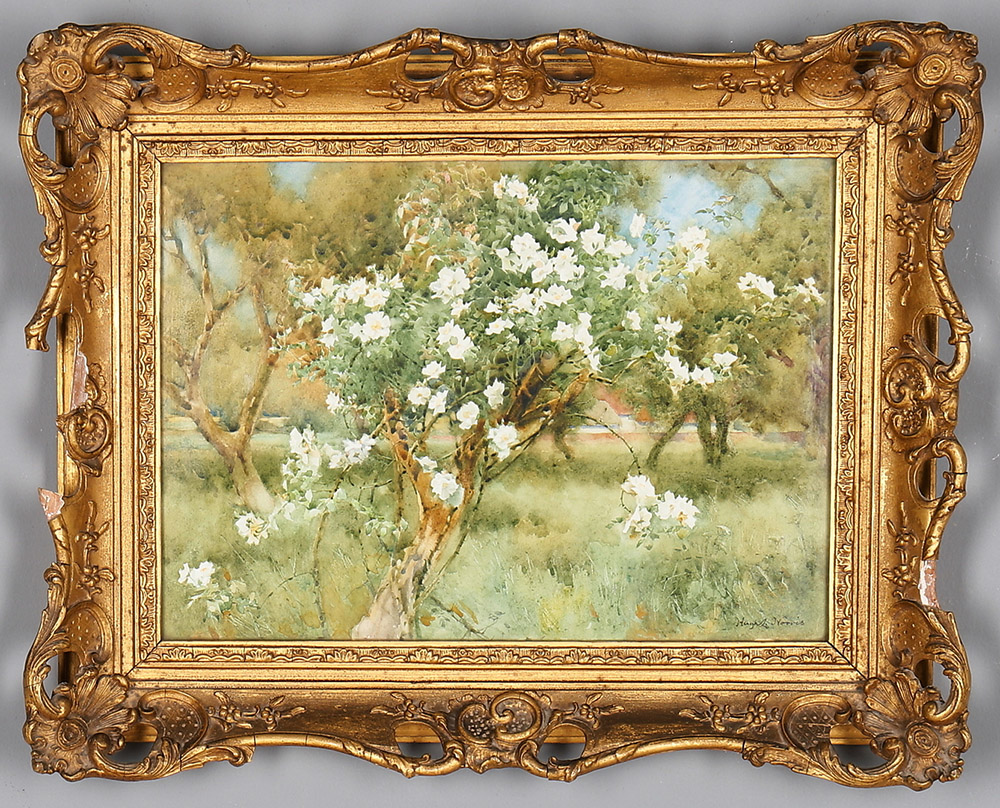
Figure 7.
An intricately carved and gilded picture frame that was produced by Charles Soar. Adapted for nonprofit, educational purposes from an internet auction site.

Figure 8.
Excerpt from the 1882 "Post Office Directory of London", showing "Varley & Soar, carvers & gilders" at 22 Great Ormond Street.
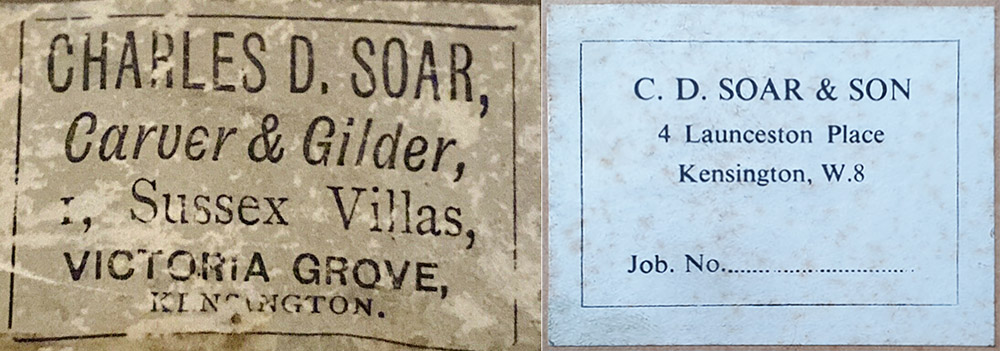
Figure 9.
Labels that were attached to the backs of framed paintings, dating ca. 1883 – 1906 (left) and after 1906 (right). Images adapted from internet auction sites.
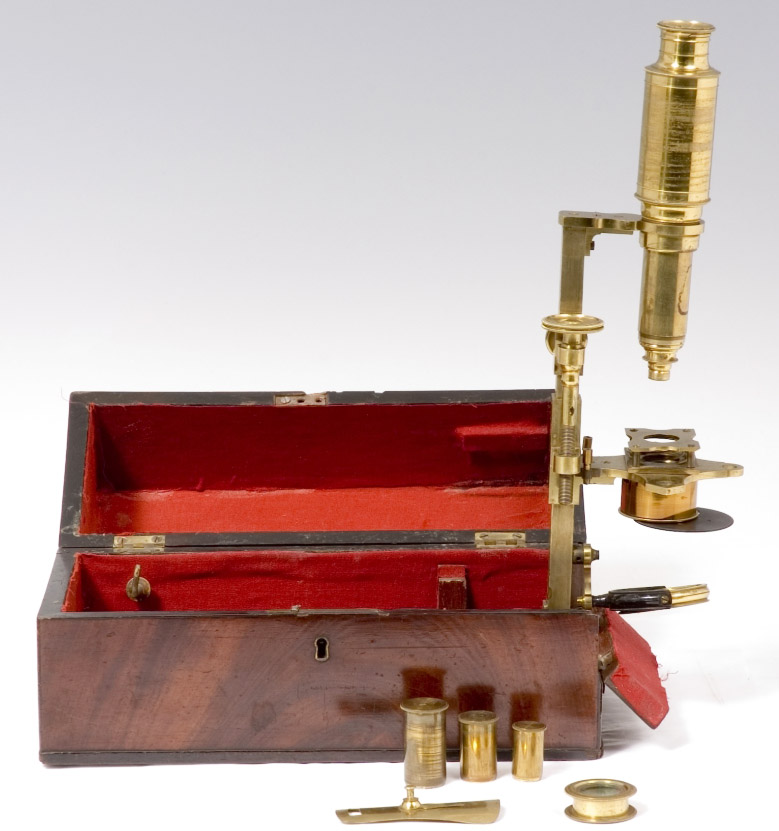
Figure 10.
A Nairne type microscope, unsigned, that was donated by C.D. Soar to the Royal Microscopical Society in 1920. It is described on page 55 of Turner's "The Great Age of the Microscope", and illustrated as Figure 27.
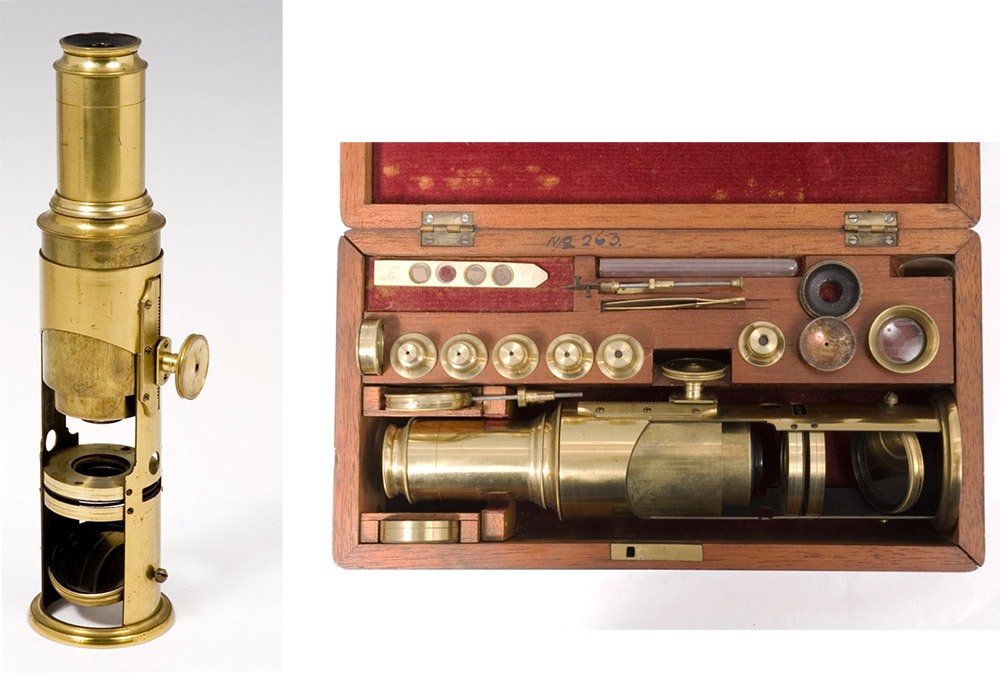
Figure 11.
An unsigned drum microscope that was donated by Charles Soar to the Royal Microscopical Society in 1928. It is described on pages 90-91 of "The Great Age of the Microscope", and shown in Figure 75.
Resources
Baker, R.A., R.A. Bayliss, and P. Soar (2009) Freshwater mites and microscopists: two British pioneers, Charles David Soar (1853-19139) and William Williamson (1869-1950), Quekett Journal of Microscopy, Vol. 41, pages 27-35
Bracegirdle, Brian (1998) Microscopical Mounts and Mounters, Quekett Microscopical Club, London, pages 86 and 172, and Plate 34-A
England census and other records, accessed through ancestry.com
Harris, G.T., and C.D. Soar (1900) Pond life in the New Forest, Science-Gossip, New Series, Vol. 7, pages 132-133
Journal of the Quekett Microscopical Club (1904) Members, "Jan, 15, 1892. Soar, C.D., F.R.M.S., 37, Dryburgh Road, Putney, S.W.", page xixJournal of the Royal Microscopical Society (1920) Fellows, "1897 Soar, Charles David, F.L.S. 37, Dryburgh-road, Putney, S.W."
National Portrait Gallery (accessed June, 2021) Charles David Soar 1883-1906, C.D. Soar & Son 1907-1997, https://www.npg.org.uk/research/conservation/directory-of-british-framemakers/s/
The Naturalists' Directory (1914) "Soar, Charles David, F.L.S., F.R.M.S., 37 Dryburgh Road, Putney, London, S.W. Hydrachnida", S.E. Cassino, Boston, page 164
Post Office Directory of London (1882)
Probate of the will of Charles D. Soar (1939) "Soar Charles David of the Crossways Hertford Heath Hertfordshire died 15 November 1839 Probate London 20 January to Francis Edwin Hawkins commercial secretary and Herbert Maurice Soar builders estimator. Effects £3225 12s 2d", accessed through ancestry.com
Proceedings of the Linnean Society of London (1911) Minutes of the meeting of March 16
Soar, C.D. (1895) British hydrachnidae, Journal of Microscopy and Natural Science, pages 152-154
Soar, C.D. (1896) Water-mites of Folkestone Warren, Science-Gossip, New Series, Vol. 3, pages 169-171
Soar, C.D. (1896) Some notes of Hydrachnidae, Journal of the Quekett Microscopical Club, Vol. 12, pages 318-321
Soar, C.D. (1906) Notes and observations on the life-history of fresh-water mites, Journal of the Quekett Microscopical Club, Series 2, Vol. 9, pages 359-370
Soar, C.D. (1917) Two new species of hydracarina or water-mites, Journal of the Quekett Microscopical Club, Series 2, Vol. 13, pages 277-282
Soar, C.D. (1936) The President's Address, Journal of the Quekett Microscopical Club, Series 3, Vol. 1, pages 185-196
Soar, C.D., and W. Williamson (1925, 1927, 1929) The British Hydracarina, Vols. I-III, Ray Society, London
Transactions of the American Microscopical Society (1918) Members, "Soar, C.D., F.R.M.S., '07...37 Dryburgh Road, Putney, London, S. W., England", page 249
Transactions of the Edinburgh Field Naturalists' and Microscopical Society (1904) Corresponding members, "Soar, Chas. D., F.R.M.S., 37 Dryburgh Road, Putney, London", page xii
Turner, Gerard L'E. (1989) The Great Age of the Microscope, Adam Hilger, Bristol, pages 55, 90-91, and 256-257
Williamson, William (1940) Charles David Soar, Journal of the Royal Microscopical Society, pages 53-55